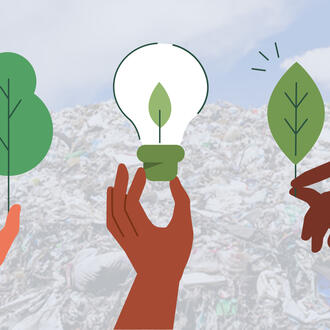Credit: Stephen Sauer
Ideas Made to Matter
In the global water crisis, an opportunity for private business
By
As the crisis over water quality and quantity deepens, scientific and policy changes are key — but so is leadership and innovation coming from the private sector.
That was one takeaway from the recent MIT Water Summit. This year’s theme, Drowning in Plastic, focused on the challenges created by plastic pollution against the backdrop of the larger water landscape: volatile weather patterns driven by climate change; overpopulation creating more water demand; and the decline of a clean water supply. Panelists noted that by 2050, there will be more plastic in the ocean by weight than fish.
Experts who spoke at and after the summit highlighted the urgent need for scientific developments and public policy — but also the role that private business can play. Here are four areas where entrepreneurs and investors can do well by doing good:
Investing in water startups
Panelist John Robinson is a partner at Mazarine Ventures, which invests in clean water and wastewater companies. Robinson said he looks for early-stage hardware and software companies that preemptively solve problems relating to water.
Many such companies are in the United States, Canada, Israel (“which punches way above their weight when it comes to water expertise”) and the Netherlands (“which is basically underwater; they’re strong because they had to be and engineer their way out of the problem”).
Mazarine invests in companies such as Flume, which offers flow analytics at the meter for insurance companies and utilities, and Simplewater, which connects laboratories with homes and businesses that need water testing.
Robinson suggested focusing on organizations that solve for water quantity, not just water quality. Most people think water scarcity is an issue, and water quality is often in the news, he said. But he bets on companies that can accurately manage and monitor water flow.
“More people die from too much water than too little water — urban flooding damages more real estate than scarcity does, and too much water flooding kills more people than scarcity does,” Robinson said.
Accordingly, he looks for technologies that move storm water away from buildings and permeable surfaces, and that prevent water from backing up and overflowing. One such example: Conservation Labs, which uses acoustic monitoring and machine learning to evaluate the water flow in pipes, identifying anomalies and alerting building operators to potential leaks.
Not all investment opportunities have to be edgy.
“You could invest in utilities and generate an even return for yourself over 15 or 20 years because people usually pay their water bills,” Robinson said. “That’s a nice, annuity-style business. Or you can invest in companies that have exposure to water or wastewater or render services in wastewater, such as Xylem or Evoqua.”
Rethinking water packaging
Some 1,500 plastic water bottles are used every second in the United States, a multifaceted problem that will require policy and rebranding to change.
In the interim, Open Water, a Chicago startup, offers water packaged in aluminum. While co-founder and chief brand officer Jess Page acknowledged that any single-use solution is not perfect, aluminum gets recycled more often than any other beverage container due to its high scrap value, whereas plastic gets “downcycled” into lower-quality materials that eventually make their way into the ocean.
Among other organizations, Open Water has partnered with aquariums and zoos, which previously relied on plastic bottle concessions. Such clients are aware of the benefits of offering environmentally friendly alternatives to their customers.
“In order to do better, they really do have to make a decision that they want to align with certain values and promote sustainability to their guests,” Page said. “And then the flip side, once they've switched away from plastic bottles, their guests are educated. They associate sustainability values with the place that they’re visiting.”
Even though her startup is thriving, Page seeks more sweeping societal changes.
“Policy could be a huge contributor to solving some of these issues,” Page said. “Plastics are far too cheap; it’s cheaper to make new plastics than it is to recycle them. [We need] a policy piece in place that either taxes plastics or makes people understand that just because it’s cheap doesn’t mean it doesn’t have consequences for society. There are plastic bag bans that are popping up, and this would fall into the same category.”
Branding municipal water
One way to reduce all types of single-use containers is to better educate consumers about the quality of their municipal water (provided it is indeed of good quality, which is not always the case).
“Ninety percent of bottled water behavior is driven by lack of trust,” said panelist Joe Vesey, senior vice president and chief marketing officer at Xylem, a global water technology provider.
“You see this in Singapore; they’re branding their municipal water. You see it in San Diego; it’s purified water. Municipalities adopting more branding and marketing techniques is really is important," Vesey said.
In South Korea, Xylem customer and governmental water provider K-Water deployed smart sensors and software to improve water quality — and shared that data with the community, Vesey said.
“The adoption of local drinking water was about one percent; then adoption went up to 35 percent. That’s still dramatically lower than what it needs to be, but behavior changes when you try to up the transparency,” he said.
Tackling microfiber pollution
Microfiber pollution is a looming marine debris issue and an opportunity for business leaders, said Rachael Miller, co-founder of the Rozalia Project, which focuses on protecting and restoring oceans.
“Microfiber pollution happens when our clothing and home textiles break down,” particularly acrylic materials, Miller explained. “The fibers that make up our clothes and home textiles break into teensy little fibers, [including] in the washing machine. … They wash out the drain and are able to get through wastewater treatment plants,” she warned, leading to pollution ingested by marine life.
“We need [innovation] in textiles, because there are opportunities to make our textiles more resilient. Is it because the wash is harsh? Is it because our textiles are weak? Is there a weave that can make them stronger?” she asked.
One low-tech solution is the Cora Ball, a laundry device that catches and captures microfibers as they shed off in the wash, but innovators “could also start working on washing machine filters or waste water treatment plant filtration systems” geared toward textiles, Miller said.
Read more sustainability coverage



